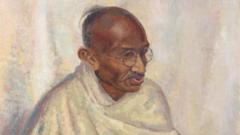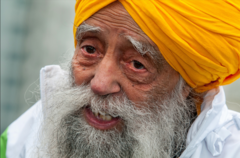The rare oil portrait of Mahatma Gandhi, painted by Clare Leighton during his visit to London for the Round Table Conference in 1931, soon goes under the hammer at Bonhams. Amid his revered status and complex legacy, the painting stands out as a notable historical artifact and subject to diverse interpretations of Gandhi's impact on Indian society.
Historic Gandhi Portrait Set to Fetch High Bids at London Auction

Historic Gandhi Portrait Set to Fetch High Bids at London Auction
A unique oil portrait of Mahatma Gandhi, painted in 1931, will be auctioned next month, capturing the attention of art collectors and historians alike.
A remarkable oil portrait of Mahatma Gandhi will soon be available for auction at Bonhams in London, with the first bids expected in the second week of July. This artwork, created by British artist Clare Leighton in 1931, is notable not just for its artistic value but also for its historical significance tied to Gandhi’s role in India's independence movement against British colonial rule.
Gandhi, often hailed as the "father of the nation," was a pivotal figure in advocating non-violent resistance, garnering immense respect from millions. The portrait is believed to be the only one for which Gandhi sat, providing a unique glimpse into his life during his visit to the UK for the second Round Table Conference, aimed at negotiating India’s constitutional reforms.
The familial lineage of Clare Leighton emphasizes the painting's historical importance, with her great nephew Caspar Leighton expressing hope that it would eventually be appreciated more broadly, particularly in India. "This is art of unique historic and cultural significance," he noted, referring to both the painting and the person it depicts.
Leighton’s connection with Gandhi came through her partner, Henry Noel Brailsford, an advocate for Indian self-governance. Her artistic portrayal captured Gandhi at the height of his influence, with previously unpublicized details of the painting being showcased at an exhibition in 1931 attended by fellow independence leaders, including Sarojini Naidu.
Subsequently, the painting’s journey has seen it primarily kept within family collections until its restoration in 1974 after an incident allegedly involving a right-wing extremist in the United States. This history highlights the complex legacy surrounding Gandhi and his life, particularly given the mixed views towards him stemming from his efforts that some right-wing groups perceive as pro-Muslim.
The auction will inevitably reignite discussions regarding Gandhi's contentious legacy in contemporary India, where perspectives on his life and philosophies remain deeply divided. Whether the painting garners attention only for its aesthetic value or sparks further debate on historical narratives associated with Gandhi remains to be seen, but its impending sale is sure to resonate across cultural and political spectrums.

















